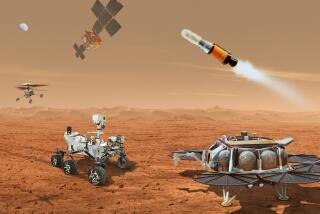NASA Cited for Shaky U.S. Space Program
- Share via
The United States, which for so many years led the world in exploration of the solar system, is drifting aimlessly while the Soviet Union has chartered a clear course that should capture major scientific prizes into the next century.
That is the inescapable conclusion reached by many scientists during an extraordinary conference in Pasadena last week that brought together top officials from every major space program in the world.
And the lack of direction in the United States cannot be blamed entirely on the explosion of the space shuttle Challenger last year, which stalled the U.S. space program, according to many scientists who attended the three-day symposium.
Instead, they laid the problem at the feet of top managers in the National Aeronautics and Space Administration who seem unsure of which targets to chose or how much of a commitment to make to planetary research, a field that could tell much about the origins and fate of planet Earth.
The frustration of U.S. scientists was put succinctly by former NASA chief Thomas Paine of Santa Monica, who chaired the presidential commission charged with charting the future of the U.S. space program for the next 20 years.
“The biggest problem is the lack of direction of the U.S. program,” he said, which adds to the difficulty in mounting major international programs that could greatly enhance the exploration of space.
“We’ve got to get our act together,” noted University of Hawaii astronomer David Morrison, a former NASA executive.
No senior NASA officials responded to those charges, but they have acknowledged that the agency is struggling to overcome recent setbacks, especially the Challenger tragedy.
What set the Pasadena meeting apart from most scientific gatherings was the unusual candor of the scientists.
“This is a new day,” said Burton Edelson, former associate administrator of NASA for space science. “It’s the first time the Russians have been this open. They’re saying what they are going to do and when they are going to do it.
“They’re feeling their oats.”
By the time the conference ended Thursday night, these objectives were clear:
- The Soviet Union has staked out Mars and the asteroid belt for intense study through the end of the century. Both objectives are dear to the hearts of planetary scientists because Mars is so much like Earth that it could tell much about the evolution of this planet and why life formed here but is not present there. The asteroids, which lie in a belt mainly between the orbits of Mars and Jupiter, are important because they offer the chance to study pristine materials from which the solar system was formed.
- The United States has virtually ruled out a major effort to explore Mars for at least the next decade because it is “premature,” according to NASA’s new chief of space science, Lennard Fisk. The most likely objective will be to send an unmanned spacecraft to the asteroid belt toward the end of the century, but even that has not been approved.
- The European Space Agency will continue its role as a participant in projects by the Soviet Union and the United States, but no bold plans were forthcoming from the Europeans--although the 13 member states of the agency have economic resources that exceed those of the United States, according to Roger Bonnet, the agency’s chief scientist. The European commitment to solar system exploration is only about one-tenth that of the United States, he added.
- Japan will continue to nurture its fledgling program, keeping mostly to itself. Minoru Oda, director of Japan’s Institute of Space and Astronautical Science, said his country will attempt several modest projects in the next decade that can be accomplished quickly, mostly consisting of orbiting observatories.
The symposium, sponsored jointly by the Jet Propulsion Laboratory and the American Institute of Aeronautics and Astronautics, grew out of the desires of many scientists to enhance the level of international cooperation in space exploration. Many space ventures, such as a manned expedition to Mars, are too costly to be carried out by a single nation and can only be achieved through international programs, many scientists believe.
There has been a dramatic growth in international cooperation in recent years, highlighted by the successful rendezvous of five spacecraft with Halley’s comet last year--two from Japan, two from the Soviet Union and one from Europe. The participants supported one another through the sharing of data that allowed the European probe to be targeted so that it passed within about 300 miles of the comet’s nucleus. Many believe this feat would not have been possible had it not been for the “pathfinder” services provided by the other probes that arrived ahead of the European craft. The United States also participated through its large tracking system, and a number of U.S. scientists contributed to experiments aboard the various probes.
Valeriy Barsukov of the Soviet Union said his country welcomes participants from other nations, and he noted that scientists from 14 countries are taking part in an unmanned Soviet expedition to the Martian moon Phobos next year.
“We always welcome cooperation,” Barsukov said through an interpreter.
He said, however, that “it seems to be very difficult to reach an agreement in this area with the United States.” U.S. participation in Soviet programs has stemmed mostly from the initiative of individual scientists, not from intergovernmental programs, several scientists said.
Barsukov noted that a recent agreement between the Soviet Union and the United States calls for “coordination, not cooperation” in joint ventures.
“The word ‘cooperation’ does not appear in the agreement,” Barsukov said, adding quickly that it was not his fault.
JPL Director Lew Allen, a former Air Force chief of staff, told the symposium that there are many obstacles to international cooperation in space, many of them political, some of them technical, but most of them have little merit.
He noted that there is much concern in this country over inadvertently giving away U.S. technological achievements by making instruments available for Soviet missions, but he indicated that the problem is largely imaginary. Between the time that such a program is approved and the instrument is supplied--a process that usually takes several years--the instrument no longer represents the state of the art and there is little danger of “technology transfer,” Allen said.
He said the problem may be more philosophical than technical.
“I am concerned with a trend in the U.S. to turn inward,” Allen said. “I think this is a dangerous tendency, and I would like to see U.S. policy shift away from this tendency.”
Generally, the symposium struck American scientists two ways:
They were stunned by the scope of the Soviet program, which will send no less than eight spacecraft to Mars within the next decade, but they were encouraged by the level of candor and exchange of information with Soviet scientists.
“I am optimistic that the anguish we feel, not only because of the Challenger but because of our inability to grasp the opportunity, is leading to some response,” said Caltech planetary scientist Bruce Murray.
That is an opportunity, several scientists noted, that the United States cannot afford to miss.
“We are seeing the beginning of the evolution of our species out into the cosmos,” Paine said. In that arena, many scientists believe, could lie the secrets to the origin of life and the future of Earth, the only spot in the universe known to have intelligent life.
More to Read
Sign up for Essential California
The most important California stories and recommendations in your inbox every morning.
You may occasionally receive promotional content from the Los Angeles Times.










